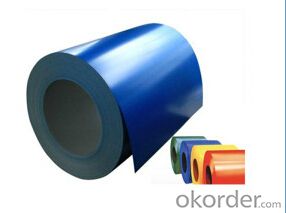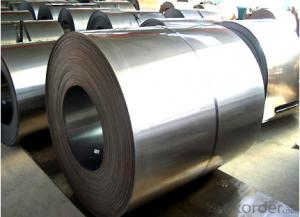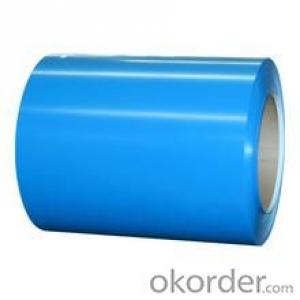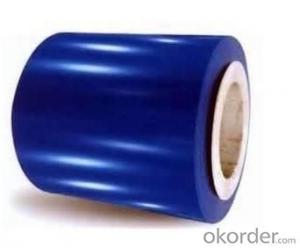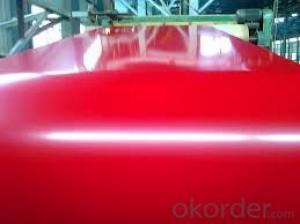Prepainted Galvanized Steel Coils for Construstion
- Loading Port:
- Shanghai
- Payment Terms:
- TT OR LC
- Min Order Qty:
- 25 m.t.
- Supply Capability:
- 10000 m.t./month
OKorder Service Pledge
OKorder Financial Service
You Might Also Like
Model NO.:CGCC, JIS3312
Surface Treatment:Coated
Certification:ISO, SGS
Technique:Cold Rolled
Standard:ASTM, JIS, GB
Application:Construction, Roofing and So on
Edge:Slit edge
Stock:Stock
Steel Grade:Q195-235
Thickness:0.16-0.8mm
Width:800-1250mm
Color:Ral Number
Zinc:30G/M2-100G/M2
Coils Weight:3-5tons/Coils
Export Markets:Global
Additional Info.
Packing:Export Standard Packing
Standard:JIS G3312
Origin:Shandong Province, China
HS Code:72107000
Production Capacity:100000tons/Year
1. PPGI, prepainted galvanized steel coil(Annual Output: 200, 000tons)
(1). Leading manufacturer in China
(2). Competitive price
(3). High quality
(4). Good after-sale service
2. The Feature of PPGI:
1). Geade: CGCC, other grade can be available
2). The thickness range of the PPGI: 0.16mm to 0.8mm
Tolerance of thickness of The PPGI: +/-0.03mm
3). Width range: 800mm to 1250mm
Tolerance of width: +/-3.00mm (aiming to +/-2.00mm)
4). Zinc coating: Z40-Z275
5). Coil internal diameter: 508mm
6). Packing: Standard waterproof paper and galvanized steel protection cover and steel strip packed
7). Applications of PPGI: Widely used for roofs, outer walls, ovens, Explosive-proof steel, electrically controlled cabinets, and industrial freezers in the Residential and industrial buildings.
The detailed information:
Price termsFOB, CFR, CIF
Payment terms30%TT in advance+70% TT or irrevocable 70%L/C at sight
Delivery time25 days after recepit of 30% TT
RemarksInsurance is all risks
MTC will be handed on with shipping documents
We accept the third party certificatation test
CNBM, has supplied the best qualities to our clients in overseas and domestic markets, based on our credit, quality, accurate shipment and prompt action to meet all the requirements of clients. And now we have export to Korea, Europe, Africa,Egypt, Middle East, South Amarica market and so on.
We assure you that our good qualified products make our esteemed clients beneficial and satidfied on their demands.
Q&A
Acceptable payment term and way?
T/T,L/C, T/T + L/C, D/P
Acceptable price term?
FOB CNF CIF DDU CPT
Do you accept OA payment terms?
Yes, sure, but it normally depending on the order value
Do you have QC team?
Yeah, sure, our QC team is very important, they will keep the qualitycontrol for our products.
What is the validity of your quotation?
Normally 7 days.
What is your advantage?
24 hour quick response /Customer oriented/ Credit foremost/ Top quality Excellent
What is your acceptable payment term?
TT,LC,OA etc
- Q: How are steel coils used in the manufacturing of industrial compressors?
- Steel coils are used in the manufacturing of industrial compressors as a crucial component for constructing the compressor's internal structure, such as the casing and housing. The steel coils provide strength, durability, and stability to the compressor, allowing it to withstand high pressure and temperature conditions. Additionally, the coils are often used in the construction of the compressor's motor, providing support and ensuring efficient operation. Overall, steel coils play a vital role in the manufacturing of industrial compressors by providing the necessary structural integrity and functionality.
- Q: Which is more reactive? Zinc or Steel? And why?
- Zinc. Steel is an alloy consisting mostly out of iron, In the reactivity seris, zinc is more reactive than iron. Therefore, zinc is more reactive than steel
- Q: I need to know which cookware set is better. We are trying to get rid of the ones we have here. They are Teflon. I have heard that stainless steel (aluminum) and hard Ionized are good, but which is the best one.
- A good quality stainless steel cookware set is a necessity- it is virtually indestructible and you can use the harshest of scrubbers to clean it. You will need a basic set that has a 8 and 12 fry pan/omelet pan, a large pot that holds a minimum of 4 quarts, and 2 sauce pots at 1 quart and 2 1/2 quart sizes. I have several pieces of hard anodized cookware too- they do a wonderful job but food will still stick. A must is at least one Green Pan- preferably a 10-12 fry pan. They are truly non-stick, clean up is a breeze and making foods like fried eggs is infinitely easier when they slide out of the pan without breaking. They do not have the same issues that plague teflon pans- scrapes and shedding that you are ultimately consuming. You can easily find them online and at your area Target store.
- Q: If rail ties were melted, would they be like any other type of steel?
- Steel okorder ... If care is not taken in the method used to melt the steel that alloy will change because the carbon will burn in the process. Also part of a steels rating is a result of heat treatments used. When melted it will loose those properties. By the way rail road ties are either wood or concrete- not steel.
- Q: How are steel coils coated?
- Steel coils are coated using a process called coil coating, where a thin layer of protective material such as paint, plastic, or zinc is applied to the surface of the steel coil. This can be done through various methods including roll coating, spray coating, or electroplating, depending on the desired coating material and application.
- Q: What are steel coils used for?
- Steel coils are used in a wide range of industries and applications, including manufacturing, construction, automotive, and appliances. They are commonly used in the production of various metal products such as pipes, tubes, sheets, and wires. Steel coils provide strength, durability, and versatility, making them essential in many industrial processes.
- Q: What are the main factors that affect the flatness of steel coils?
- The main factors that affect the flatness of steel coils include the quality of the raw material used, the thickness and width of the coil, the temperature and humidity during the manufacturing process, the tension applied during coiling, and the cooling and leveling processes employed.
- Q: How are steel coils used in the production of metal panels?
- Metal panels require steel coils as an essential component in their production. These coils, typically made from high-quality steel, act as the raw material for manufacturing different types of metal panels. To initiate the production process, specialized machinery is used to unroll and flatten the steel coils. This process guarantees a consistent and uniform thickness throughout the sheet. Following this, the flattened steel is cut into the desired length and width, depending on the specific requirements of the metal panel being produced. After the steel has been cut, it undergoes further processing, including cleaning and coating. This step aims to eliminate any impurities and safeguard the steel against corrosion or damage. The coating also enhances the appearance of the metal panel and provides additional durability and longevity. Once the cleaning and coating process is complete, the steel sheets are shaped into the desired form using various techniques such as roll forming or stamping. This enables the creation of diverse metal panels, including roofing panels, wall panels, and decorative panels, among others. The selection of steel coils for metal panel production is based on their strength, durability, and versatility. Steel is renowned for its exceptional structural properties, making it the ideal material for constructing sturdy and long-lasting metal panels. Moreover, steel exhibits high resistance against environmental factors like extreme weather conditions, further enhancing the durability of the metal panels. In conclusion, steel coils play a critical role in the production of metal panels by serving as the raw material and undergoing various processes to ensure quality and durability. The utilization of steel coils enables the production of a wide range of metal panels suitable for various industries and applications.
- Q: I have a steel string, Yamaha acoustic guitar that I am learning to play at home. But at school I use a rented nylon string guitar. I like the feel of the nylon strings better then the steel strings and i was wondering if i can just switch strings or if i should just get another guitar. Can anyone help?
- confusing thing. query using bing and yahoo. this will help!
- Q: What are the weight ranges of steel coils?
- The weight ranges of steel coils can vary depending on their dimensions and intended use. Generally, steel coils can range from a few hundred pounds to several tons in weight. For example, hot-rolled steel coils typically weigh between 10 and 25 tons, while cold-rolled steel coils can weigh anywhere from a few hundred pounds to 20 tons. The weight of steel coils can also vary based on factors such as the thickness and width of the coil, as well as the grade and type of steel being used. Ultimately, the weight range of steel coils is determined by the specific requirements of the industry and application in which they are being used.
Send your message to us
Prepainted Galvanized Steel Coils for Construstion
- Loading Port:
- Shanghai
- Payment Terms:
- TT OR LC
- Min Order Qty:
- 25 m.t.
- Supply Capability:
- 10000 m.t./month
OKorder Service Pledge
OKorder Financial Service
Similar products
Hot products
Hot Searches
Related keywords



